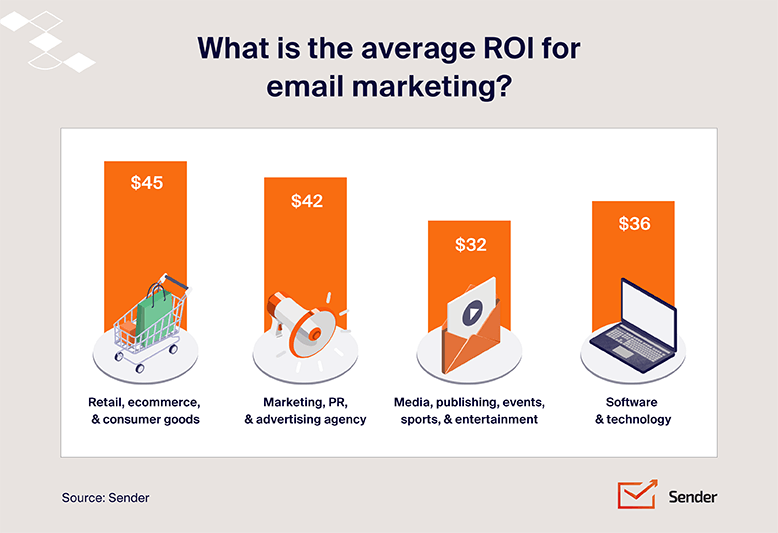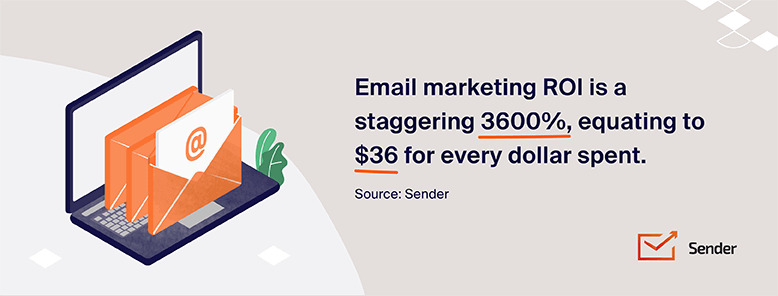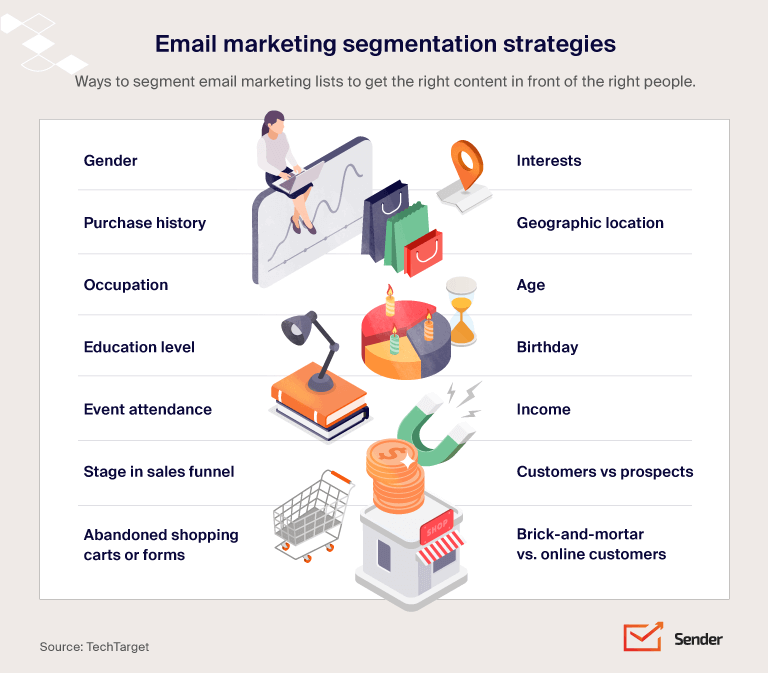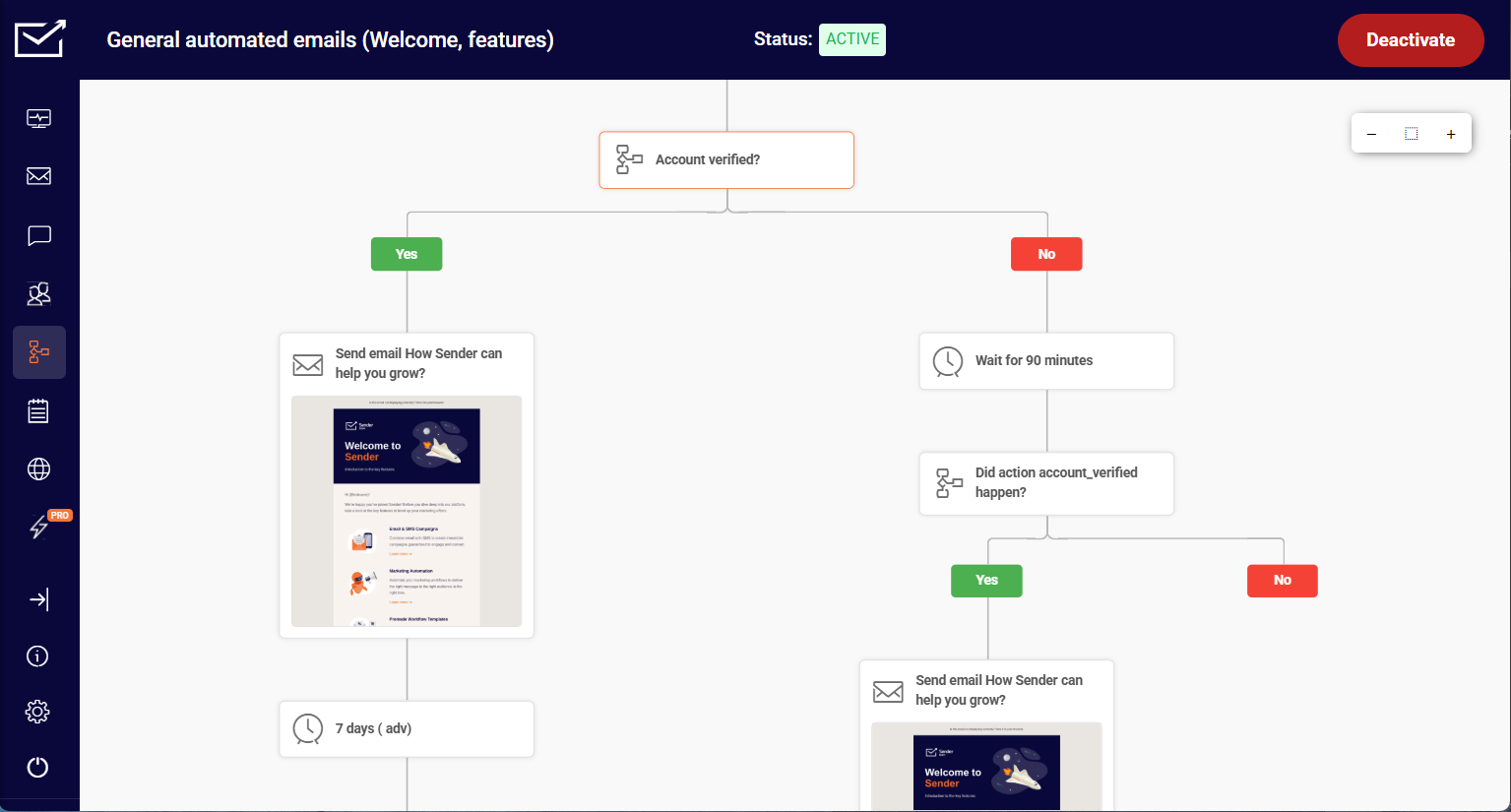Let’s face it—email marketing campaigns aren’t going anywhere anytime soon. Despite all the buzz around new social platforms, email marketing continues to be the workhorse of the online marketing world.
I’ve been watching the trends for years, and the email marketing statistics don’t lie—email delivers results and effectiveness that other channels in your overall marketing strategy simply can’t match.
So What Exactly is Email Marketing ROI?
Email marketing ROI (Return on Investment) is basically how much money you make compared to what you spend on your email marketing efforts. It’s not rocket science, but getting this essential metric right makes all the difference between wasting your marketing budget and seeing real growth in your email marketing revenue.
The basic formula for measuring email marketing return on investment looks like this:

I’ll be honest — if you’re not tracking this number, you’re flying blind. Think about it: if you spent $500 on marketing emails that brought in $5,000, that’s a 900% email marketing return. You’d want to know that, right?
According to a 2023 study by Litmus, most email marketers who carefully track their ROI report significantly better results than those who don’t. Makes sense when you think about it — you can’t improve what you don’t measure. That’s why an email marketing ROI calculator has become an essential tool for many marketers worldwide.
Why Should You Care About Email Marketing ROI?
I remember talking to a marketing director who couldn’t figure out why her boss kept cutting her email marketing strategy budget. Turns out, she wasn’t measuring ROI on email marketing at all! Without concrete email marketing stats showing how her messages were contributing to the bottom line, her budget was an easy target.
Here’s why campaign ROI tracking isn’t optional anymore for a successful email strategy:
- It gives you ammunition when budget discussions come around (trust me, you’ll need it);
- You’ll know exactly which email marketing campaigns are worth repeating and which ones bombed;
- Year-over-year comparison helps prove you’re getting better at driving email engagement;
- It forces you to think about email as a revenue channel for specific actions, not just for sending emails.
Campaign Monitor’s 2023 report found that 73% of companies who increased their budgets for email marketing efforts did so because they could demonstrate positive ROI growth using email marketing ROI statistics. That number speaks volumes about the importance of measurement for improving email marketing ROI.

What’s Considered “Good” ROI These Days?
You’ve probably seen that famous statistic floating around — $36 return for every dollar spent on email marketing. That figure comes from the Direct Marketing Association’s 2019 report about ROI in marketing, and while it sounds amazing, it’s actually the average ROI for email marketing across various industries based on current email marketing stats.

Your mileage will definitely vary depending on:
- Your company size (DMA found that businesses with 500+ employees see about 41:1 ROI in their email marketing efforts);
- Team makeup (interestingly, teams of 3-5 people tend to see better results than larger teams, according to a 2022 Mailchimp study);
- Industry (B2B tends to have longer sales cycles but higher average order values);
- Campaign types (email automation sequences consistently outperform one-off broadcasts — sometimes by 3x or more);
- Target audience engagement (campaigns to highly engaged email subscribers perform better)
- Mobile optimization (with so many email users checking messages on mobile devices, this is crucial).
If you’re just starting out, don’t get discouraged by these email marketing ROI statistics. I’ve seen brands start with a modest 5:1 ROI and work their way up to 25:1 within a year of focused optimization of their email marketing strategy.
Here’s the average ROI by industry according to Litmus study:
- Retail, ecommerce, & consumer goods: 45:1;
- Marketing, PR, & advertising agency: 42:1;
- Software & technology: 36:1;
- Media, publishing, events, sports, & entertainment: 32:1
The key is progress, not perfection. Are your numbers improving quarter over quarter? That’s what really matters for campaign effectiveness.
How to Calculate Your Email Marketing ROI (Step-by-Step)?
Let me walk you through how this works in practice:
Step 1: Get Clear on Your Goals
This seems obvious, but you’d be surprised how many email campaigns go out without a clear objective. Are you trying to:
- Drive immediate sales?
- Nurture leads who aren’t ready to buy?
- Increase repeat purchases from existing customers?
- Build awareness for a new product line?
Each of these goals requires different marketing ROI metrics and approaches for ROI calculation. Hubspot’s 2023 Email Benchmarks Report found that campaigns with clearly defined goals outperformed general newsletters by 49% in terms of engagement.
Step 2: Track All Your Costs (And I Mean ALL of Them)
This is where many email marketers cut corners, and it skews their ROI calculations. You need to account for total costs:
- Your ESP costs — whether it’s Mailchimp, Constant Contact, or an enterprise solution;
- Team time — including planning, writing, designing, testing and analyzing (be honest about how many hours at what hourly rate actually go into each campaign);
- Content costs — if you’re hiring freelancers or agencies for copy, dynamic content, or design;
- List building expenses — those lead magnets to generate leads and acquire new leads aren’t free;
- Any specialized tools you use just for email (like subject line testers, preview text optimizers, etc.).
Don’t forget to factor in your own time! I’ve talked to so many small business owners who don’t count the hours they spend on email marketing campaigns because “it’s just me doing it.” Your time has value — include it in your email marketing ROI calculator.
A 2022 Litmus survey revealed that 64% of marketers worldwide underestimate their true email marketing costs by leaving out at least one major expense category. Don’t make that mistake when measuring email marketing ROI.
Step 3: Measure What Email Actually Brings In
This gets tricky because not all email revenue is immediately obvious. But you should track the following, at least:
- Direct revenue (the easiest to measure — sales directly attributed to email clicks);
- Influenced revenue (harder to track but important — purchases that marketing emails played a role in);
- Lead generation value (if you know your ability to generate leads and convert them to customers);
- Customer retention impact (how email builds customer loyalty and prevents churn — this can be substantial).
A good analytics setup that leverages customer data makes this much easier. According to a 2023 Klaviyo study, businesses using proper attribution models for their email marketing efforts reported 37% higher email ROI than those using simplistic tracking.
I’ve found that most email platforms overstate revenue attribution for marketing emails, while general analytics platforms like Google Analytics often understate it. The truth is usually somewhere in between. The key is consistency in how ROI marketing is measured over time.
Step 4: Do the Math (It’s Not That Painful)
Once you have your numbers:
- Add up all your costs for the period you’re measuring
- Calculate the total revenue generated
- Plug them into the ROI formula for marketing: [(Revenue – Cost) ÷ Cost] × 100
So if you spent $1,000 total on email marketing last month and generated $10,000 in sales, your ROI would be 900%.
[(10,000 – 1,000) ÷ 1,000] × 100 = 900%
That means every dollar you invested brought back nine dollars in profit (plus the original dollar). Not too shabby!
Email Marketing ROI Calculator
If numbers make your head spin, and you don’t want to calculate the ROI manually, there are tools that help you calculate your email marketing ROI.
All you need to do is add your metrics like the cost of your email marketing campaign, average volume sent, open rates, conversion rate, and value of conversion. The ROI calculator will do the calculation for you and show you instant results.
One such email ROI calculator we found was Drip’s email marketing ROI calculator. It’s pretty straightforward and provides instant answers, whether you’re looking for ROI numbers for your own brand or a client.
Steps to Increase Email Marketing ROI
I’ve audited hundreds of email programs over the years, and certain strategies consistently deliver better results. Here’s what actually moves the needle:
1. Clean Your Email List Regularly
It may sound counterintuitive, but trimming your email list actually increases ROI.
Why? Because sending emails to inactive or invalid addresses hurts your deliverability, open rates, and sender reputation.
So, you should clean your email list at least once every 3–6 months. Particularly look for the following contacts and remove them:
- Contacts that haven’t opened anything in 90+ days;
- Hard bounces and invalid addresses;
- Unengaged freebie hunters who never converted.
This will not only increase your engagement rates over time but will boost your chances of building a solid community that appreciates your brand (and reciprocates your efforts).
Pro tip: Before removing inactive subscribers completely, send a re-engagement email campaign. If they still ghost you? Time to say goodbye. Remember, quality > quantity, always.
2. Get Serious About Segmentation
Mass emails to your entire list of email subscribers are rarely the best approach for your target audience. A 2023 study by Epsilon found that segmented email marketing campaigns drive 760% more email marketing revenue than one-size-fits-all blasts. That’s not a typo — 760%!
The simplest segments that deliver results for improving email marketing ROI are:
- Past purchases (what they’ve bought determines what they might buy next);
- Email engagement level (highly engaged subscribers vs. those who rarely open);
- Where they came from (different lead sources often have different buying behaviors);
- Geography (especially if you have location-specific offers or exclusive discounts);
- Device preferences (tailoring experiences for those who open primarily on mobile devices).
I worked with a retailer who segmented based on category affinity (which consumer goods your customers browse the most) using their customer data. Their conversion rates jumped by 34% almost overnight, dramatically boosting their email marketing return. The data was already there — they just needed to use it as part of their email strategy.

3. Use Personalized Emails
Personalized emails can deliver 6x higher transaction rates, and we’ve seen it firsthand. The more your emails feel like they were written for one person, the better your ROI gets. Personalization isn’t just nice to have anymore—it’s expected. Research shows that 71% of consumers expect personalized interactions, while 76% get frustrated when companies don’t deliver.
But nobody gets excited about an email that says, “Hi [FirstName], check out our new arrivals.”
Personalization goes beyond just using someone’s name. It’s about sending relevant, timely content based on behavior. Think of a skincare brand sending different follow-up emails based on a customer’s skin type (oily, dry, or combination).
True personalization isn’t just about names, it’s about relevance. Here’s what works:
- Recommend products based on past browsing or purchase behavior;
- Send birthday or anniversary surprises;
- Reconnect with “Hey, it’s been a while” messages for inactive users.
4. Time Your Emails for Maximum Impact
We’ve all been there—testing email sends at different times for the same audience and same content. Still, we get different results. Right?
If you’ve still not tried this tactic, we highly suggest you do because when you send your emails matters just as much as what’s inside them. And when you get your timing right, you don’t just show up, you show up at the perfect moment.
But don’t rely on guesswork — test different send times and days to find your sweet spot.
Here are the best times to send an email based on latest data:
- Midweek works best for most businesses (Tuesday–Thursday);
- Avoid weekends unless you’re in ecommerce or entertainment;
- Send between 9 AM–12 PM for B2B, evenings for B2C sometimes work wonders;
- Always consider your audience’s time zone, not yours when scheduling emails.
The best approach is however to test continuously, learn, and adapt. What works for a SaaS startup might bomb for a fashion brand.
5. Automate the Customer Journey
One-off email marketing campaigns have their place, but email automation consistently delivers higher ROI. According to a 2022 GetResponse study, automated emails generate 320% more revenue per email than non-automated campaigns, making them essential for improving email marketing ROI.
Start with these high-impact automations for your email marketing strategy:
- Welcome series (Omnisend research shows these convert at 52% higher rates and drive higher open rates than standard campaigns);
- Abandoned cart recovery (these recover 10-15% of otherwise lost sales, per Barilliance);
- Post-purchase follow-ups (increase customer loyalty and repeat purchases by 31%, according to Klaviyo);
- Re-engagement campaigns for inactive subscribers (win back campaigns that generate one response from previously lost customers).
I’ve seen brands triple their email marketing revenue by simply implementing these four automation sequences. They take time to set up initially, but they’re basically money printing machines once they’re running. These specific actions that occur automatically based on customer behavior represent the pinnacle of effectiveness in modern email marketing efforts.
Sender’s intuitive automation builder and premade workflow templates make automating your campaigns easy as 1-2-3. The best part — it’s free!

6. Include Clear CTAs
Your email can be beautiful, persuasive, and well-written, but if the call-to-action isn’t clear, it won’t convert.
One of the biggest mistakes we see? Emails that try to do too much — “Read this, buy that, follow here, check this link too.” And the result? The reader does nothing.
Here’s the golden rule: One email. One goal. One CTA. Look at these examples:
- “Grab Your 20% Off”
- “Book Your Free Call”
- “Explore the Collection”
Use action words, make it stand out visually, and don’t bury it in a wall of text. Use white space. Repeat the CTA if needed, once above the fold, once at the end. The clearer your ask, the better your results.
7. Test Everything (But Not All at Once)
A/B testing sounds boring, but it’s the secret weapon of high-performing email marketing campaigns. Campaign Monitor reports that email marketers who regularly test their messages see 37% higher ROI than those who don’t.
Focus your testing on these high-impact elements to boost effectiveness:
- Subject lines and preview text (they determine whether emails get opened at all);
- CTA placement and wording (directly impacts conversion rates);
- Email send timing (can affect higher open rates by up to 22%);
- Content format (short vs. long, text vs. images, dynamic content vs. static);
- Mobile responsiveness (how your emails appear across different mobile devices).
The key is changing just one element at a time so you know exactly what caused the improvement in your email marketing stats. I’ve seen subject line testing alone improve open rates by 25-30% over time through consistent optimization. This kind of systematic approach is an important metric for any serious email strategy.
What Email Metrics Should You Watch Besides ROI?
While ROI is the ultimate measure to track success, these supporting email marketing stats help diagnose issues and spot opportunities:
Open Rates
Industry average is around 18% according to Mailchimp’s 2023 benchmarks on email marketing statistics, but it varies widely by industry. What matters most is your trend over time and achieving higher open rates through optimization.
Pro tip: Apple’s Mail Privacy Protection has made open rates less reliable since 2021. Focus more on clicks and conversions if a large percentage of your email subscribers use Apple Mail on their mobile devices.
Click-Through Rates
This important metric shows how compelling your content and offers are in your marketing emails. Average is 2-5% according to Campaign Monitor, but top performers often see double digits in email engagement.
Low opens + high clicks = your subject lines need work but your content is solid High opens + low clicks = great subject lines but your content isn’t delivering specific actions.
Conversion Rate
This is the percentage of email recipients who take your desired action. It’s the most direct predictor of email marketing ROI and effectiveness.
According to WordStream, the average email conversion rate is 4.29%, significantly higher than most other marketing channels, which explains why email remains central to many a marketing strategy.
Revenue Per Email
This essential metric (total email marketing revenue ÷ number of messages sent) helps you compare campaign performance at a glance and is useful for measuring email marketing ROI.
A 2023 study by Omnisend found that average revenue per email ranges from $0.08 to $0.26 depending on industry and email marketing campaign type.
But that’s not all! Check out all 17 email marketing metrics you should be tracking.
Sources
- “$42 return for every dollar spent on email marketing” – Direct Marketing Association (DMA) Report 2019 URL: https://dma.org.uk/research/marketer-email-tracker-2019
- “Businesses with 500+ employees see about 41:1 ROI” – DMA Email Benchmarking Report URL: https://dma.org.uk/research/email-benchmarking-report-2018
- “Segmented campaigns drive 760% more revenue than one-size-fits-all blasts” – Epsilon Email Marketing Study URL: https://www.epsilon.com/us/about-us/pressroom/new-epsilon-research-indicates-80-of-consumers-are-more-likely-to-make-a-purchase-when-brands-offer-personalized-experiences
- “Automated emails generate 320% more revenue per email than non-automated campaigns” – GetResponse Email Marketing Benchmarks URL: https://www.getresponse.com/resources/reports/email-marketing-benchmarks
- “Welcome emails convert at 52% higher rates than standard campaigns” – Omnisend Research URL: https://www.omnisend.com/blog/welcome-emails/
- “Abandoned cart recovery emails recover 10-15% of otherwise lost sales” – Barilliance Cart Abandonment Statistics URL: https://www.barilliance.com/cart-abandonment-rate-statistics/
- “Post-purchase follow-ups increase repeat purchases by 31%” – Klaviyo Benchmark Report URL: https://www.klaviyo.com/blog/ecommerce-email-marketing-statistics
- “Marketers who regularly test their emails see 37% higher ROI” – Campaign Monitor Email Marketing Statistics URL: https://www.campaignmonitor.com/resources/guides/email-marketing-statistics/
- “Email send timing can affect open rates by up to 22%” – MailChimp Send Time Optimization Study URL: https://mailchimp.com/resources/insights-from-mailchimps-send-time-optimization-system/
- “Industry average open rate is around 18%” – Mailchimp Email Marketing Benchmarks URL: https://mailchimp.com/resources/email-marketing-benchmarks/
- “Welcome emails achieve open rates as high as 82%” – GetResponse Email Marketing Statistics URL: https://www.getresponse.com/resources/reports/email-marketing-statistics
- “Including the word ‘video’ can increase opens by 19%” – Syndacast Email Marketing Report URL: https://www.syndacast.com/video-email-marketing-statistics/
- “47% of email subscribers decide whether to open an email based solely on the subject line” – Invesp Conversion Rate Optimization URL: https://www.invespcro.com/blog/email-subject-lines-statistics-and-best-practices/
- “Average email click-through rate is 2-5%” – Campaign Monitor Email Benchmarks URL: https://www.campaignmonitor.com/resources/guides/email-marketing-benchmarks/
- “Average email conversion rate is 4.29%” – WordStream Email Marketing Statistics URL: https://www.wordstream.com/blog/ws/2017/06/29/email-marketing-statistics
- “73% of companies who increased their email budgets did so because they could demonstrate positive ROI growth” – Campaign Monitor ROI Report URL: https://www.campaignmonitor.com/resources/guides/email-marketing-roi/
- “Only 25% of companies believe they’re adequately tracking email ROI” – Econsultancy Email Marketing Census URL: https://econsultancy.com/reports/email-census/
- “64% of marketers underestimate their true email costs by leaving out at least one major expense category” – Litmus State of Email Survey URL: https://www.litmus.com/resources/state-of-email/
- “Businesses using proper attribution models reported 37% higher email ROI” – Klaviyo Attribution Study URL: https://www.klaviyo.com/blog/attribution-models-for-ecommerce
- “Average revenue per email ranges from $0.08 to $0.26” – Omnisend Ecommerce Statistics Report URL: https://www.omnisend.com/blog/ecommerce-email-marketing-statistics/
- “4.3 billion email users worldwide” – Statista Global Email Users URL: https://www.statista.com/statistics/255080/number-of-e-mail-users-worldwide/
- “99% of consumers check email daily” – HubSpot Email Marketing Statistics URL: https://blog.hubspot.com/marketing/email-marketing-stats
- “Personalized emails deliver 6x higher transaction rates” – Experian Email Marketing Study URL: https://www.experian.com/assets/marketing-services/white-papers/ccm-email-study-2Q2016.pdf
- “Mobile-responsive emails see a 15% higher click rate” – MailChimp Mobile Email Statistics URL: https://mailchimp.com/resources/research/effects-of-mobile-use-on-email-engagement/
- “54.9% of ‘Email My Cart’ triggered emails successfully converted customers” – Barilliance Triggered Email Report URL: https://www.barilliance.com/triggered-email-conversion-statistics/
- “36% of consumers claim that email is their primary way to learn about changes at a company” – Adobe Email Usage Study URL: https://www.adobe.com/content/dam/acom/en/sensei/pdfs/Adobe_Consumer_Email_Survey.pdf
- “Average ROI by industry” – https://www.litmus.com/blog/infographic-the-roi-of-email-marketing
- “71% of consumers expect personalized interactions, while 76% get frustrated when companies don’t deliver” – https://www.mckinsey.com/capabilities/growth-marketing-and-sales/our-insights/the-value-of-getting-personalization-right-or-wrong-is-multiplying

